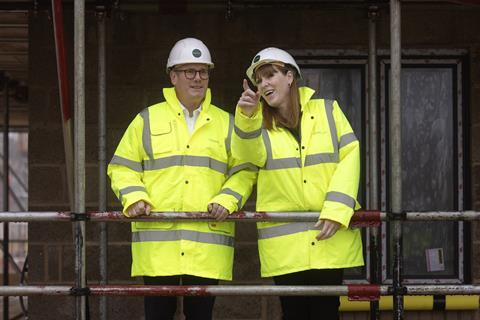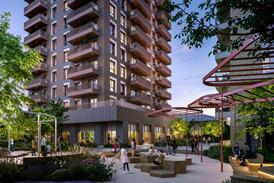Focus on design quality praised but concerns remain around capacity of industry to complete schemes
The built environment has broadly welcomed the government’s revisions to the National Planning Policy Framework (NPPF) despite some experts warning there may still be some issues for viability of schemes.
Angela Rayner unveiled the government’s finalised plans to speed up the planning system yesterday in its formal response to its NPPF consultation, which sought views on proposals to enable the construction of 1.5 million homes by 2029.

The final document included requirements for new developments to be “visually attractive”, sympathetic to local character and history, and create a strong sense of place while ensuring inclusivity, accessibility and wellbeing.
> Also read: NPPF: Government drops 50% affordable housing requirement for grey belt sites
RIBA president Muyiwa Oki said yesterday’s revisions “offer a promising path forward” but called for greater involvement of architects and more resources for planning authorities.
“Enhanced emphasis on design quality and sustainability reflects a clear understanding of what constitutes good design, paving the way to create places where people truly want to live,” he said.
He added that moves to define the meaning of grey belt were significant and “signal a willingness to tackle some of the most pressing barriers to large-scale development”.
But he said: “Most importantly, this cannot become a solely numbers-driven exercise. In our cities, towns and countryside people deserve high-quality, well-designed homes that meet their needs and stand the test of time.”
Planning consultants have mostly welcomed Rayner’s decision to reduce affordable housing requirements on grey belt land, which had been criticised by developers as too onerous and threatening viability.
Changes in the final document included a significant watering down of a previous requirement for schemes on the “grey belt”, a new land class defined as areas of the green belt which do little to protect the countryside, to contain 50% affordable housing.
These schemes will now only need to include 15% affordable housing above local housing policies, up to a cap of 50%.
Jason Lowes, planning partner at Rapleys, said “it has to be recognised that 50% of nothing is nothing and we need viable development to come forward”.
But Lowes said concerns remained, including the need to do more to target development where housing is the least affordable and the lack of detail in the NPPF about the shortages of skills needed to get schemes built.
“There has been little said by the Government about the mechanics of actual delivery, or about the talent needed to build these homes,” he said.
“We have known about the increase in planners to get through casework for some time but this does not solve the very real problem of building them.
“This could be the missing piece of the puzzle because 1.5m homes in five years when we are at fewer than 200,000 this year will require the construction industry to expand quite dramatically, and very quickly.”
Craig Pettit, planning director at planning consultancy Marrons, said “you’d be forgiven for being a little disappointed” by the final document compared to the consultation draft but said there were “still some fundamental positives”.
These included changes to the planning committee process, which would allow applications which align with local planning policies to be decided using delegated powers rather than needing to face a vote at a planning committee.
“For too long politics has been the driving force behind planning decisions, and while it should always have its place, trained professionals should be trusted to deliver housing and infrastructure in a sustainable, considered and strategic way. We can see that Labour is starting to tackle this issue,” he said.
“Committees refuse planning applications for a variety of reasons, some of which are motivated by a fear of change rather than the rationale behind whether a development is necessary or will be beneficial. Seldom are applications that are recommended for approval by officers, rejected at planning committee for sound planning reasons”.
Pettit said the changes would allow planning professionals to do their job and help to relieve pressure on the system at a local level.
Emelye Kenyon, director and head of environmental services at multi-disciplinary consultancy Pick Everard, welcomed the government’s clarification of the meaning of grey belt but said some issues remain.
Developers will need to demonstrate that their site does not fundamentally undermine the purposes of the remaining green belt, which Kenyon said could prove difficult to overcome.
“There is still therefore a priority to be given to previously developed land in the first instance where brownfield land isn’t an option for the scheme in question,” she said.
“It does appear that this has been designed to ensure the protection of the wider green belt, but it is important to recognise it marks a significant step towards development being possible within the green belt.
“The hope remains that moving into the future, this planning reform meets that overall aim of progressing development forward in a way that creates positive transformation for communities, without impacting the natural spaces and biodiversity within the country’s green belt.”
Meanwhile, the UK Green Building Council said the updated NPPF had only made a “small step” towards achieving greener and healthier communities and proposed linking the framework with climate change policies.
The group’s co-head of policy and places Anna Hollyman said: “Attention on high-quality, sustainable buildings is welcome, but this needs to be complemented by a Future Homes Standard which is fit for purpose and supports ambitious local authorities that want to deliver homes that are energy efficient and comfortable both now and in the future.
“The planning system should work with nature, not against it. Protecting and integrating biodiversity and providing access to nature is essential to achieving the goal of creating climate safe, healthy and thriving communities. This means conducting biodiversity assessments on all sites, rather than assuming a greenlight for all brownfield development.”
The changes to the NPPF, published in draft form in July, also confirmed increases in housing targets, which will once again be mandatory, with local councils now expected to demonstrate how they will meet a combined annual target of 370,000 homes. The previous housing targets, which were advisory, had a combined total of just 305,000.
Under the finalised NPPF, areas with the highest unaffordability and greatest potential for growth will see targets increase, according to the government, while stronger action is planned to ensure councils adopt new plans.
The target has increased by 7,300 in London, compared to the summer, and has also risen slightly in the South-east and East of England regions. The target has fallen in all other areas compared to the consulted version, with the biggest drop in Yorkshire and the Humber.
















No comments yet